-
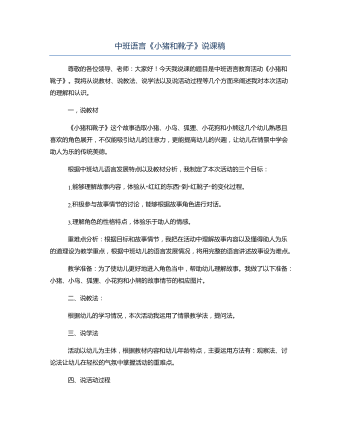
中班语言《小猪和靴子》说课稿
(一)情景导入,引出故事我将出示靴子的图片,结合提问法引出主题。我会用神秘的口吻问:“小朋友们,树林里有只可爱的小猪捡到老师手中拿的这个东西,可是他不知道这是什么,让我们一起帮他想想是什么,好吗?”然后一一提问,以得到各种不同的答案,激发幼儿的想象和兴趣。(二)讲述故事,理解内容1、首先我用生动有趣的语言配合靴子图片将《小猪和靴子》完整的讲述一遍。2、其次我会提问:故事发生在什么地方?故事中都有谁?它们都说了什么?你喜欢故事中的小猪吗?为什么?(帮助幼儿总结出小猪的性格特点--憨厚、善良、助人为乐)等等。3、再次出示相应的图片完整的讲述故事内容,让幼儿利用故事角色对话。4、引导幼儿自由讨论,如:你丢过东西吗?心里怎么样?如果别人捡到了,还给你,你心里又会怎么样?那如果你捡到了东西会怎么做?
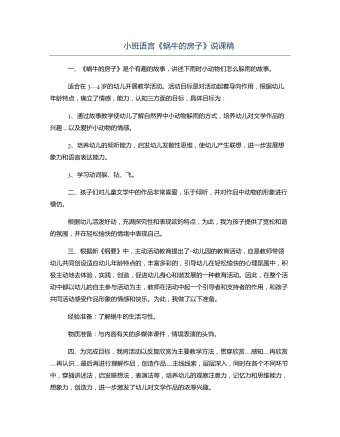
小班语言《蜗牛的房子》说课稿
感知法,欣赏作品。1、了解作品的内容2、进而理解作品的风格,在这一环节中根据幼儿年龄小,注意力难以长时间集中等特点,运用多种多样欣赏手段和方法:如“听磁带中的作品,师有表情的复述作品以及观看多媒体课件多种辅助教学手段,引导幼儿欣赏,使幼儿在积极主动的姿态参与活动。第三部分:表现法采用:角色扮演以及角色互换等教学方法。鼓励幼儿大胆仿编创编作品。注意难点部分:在这一环节中,鼓励幼儿尝试用各种角色来创编作品,既激发了幼儿积极创作的欲望,又能使幼儿顺利迁移已有的经验,这会使幼儿感受活动给他们带来的成功感和满足感,如果孩子对作品创编活动比较顺利,也可同伴之间交流,角色互换,或者同伴之间创编接龙,如小鸟换成小青蛙,小松鼠等。通过持续不断地感受作品,激发幼儿想象力,丰富其语言词汇,还能生成其他有价值的活动。

小班艺术《好玩的刷子》说课稿
由于小班幼儿还在绘画阶段的涂鸦期。他们的各方面的能力还比较薄弱。受自身能力的限制。如果我们沿着传统的美术教育观,过多的用蜡笔和白纸取代所有的绘画活动,进行“依样画葫芦”,那我们既违背了《纲要》的精神,也违背了幼儿身心发展的规律。幼儿创造能力和个性化的培养就无从谈起了。因此本次活动根据小班幼儿的年龄特点,以他们喜欢情境式活动为依据,我采用邮递员送信,变魔术的游戏情境,激发幼儿参与活动的兴趣。通过玩刷子、刷色活动,引导幼儿学习刷画的技能,让幼儿在学中玩,玩中学,化被动学习为主动参与。刷画后出来的效果比较突出,在视觉上有冲击力,适合小班幼儿的审美特点,从而激发他们的创作欲望,进而培养他们对艺术活动的兴趣。

新人教版高中英语必修3Unit 1 Festivals and Celebrations-Reading for writing教学设计二
Step 3 Analyzing article structureActivity 31. Teachers raise questions to guide students to analyze the chapter structure of this diary and think about how to describe the festival experience. (1)What should be included in the opening/body/closing paragraph(s)?(2)How did the writer arrange his/her ideas?(3)What kind of interesting details did the writer describe?(4)How did the writer describe his/her feelings/emotions during the event?2. Students read and compare the three sentence patterns in activity 2. Try to rewrite the first paragraph of the diary with these three sentence patterns. After that, students exchange corrections with their partners. Such as:●This was my first time spending three days experiencing the Naadam Festival in China’s Inner Mongolia Autonomous Region and it was an enjoyable and exciting experience. ●I'll never forget my experience at the Naadam Festival because it was my first time to watch the exciting Mongolian games of horse racing, wrestling, and archery so closely. ●I'll always remember my first experience at the Naadam Festival in China’s Inner Mongolia Autonomous Region because it was so amazing to spend three days witnessing a grand Mongolian ceremony. Step 4 Accumulation of statementsActivity 41. Ask the students to read the diary again. Look for sentences that express feelings and emotions, especially those with the -ing form and the past participle. Such as:● …horse racing, wrestling, and archery, which are all so exciting to watch. ● some amazing performances● I was surprised to see…● I was a little worried about. . . ● feeling really tiredOther emotional statements:●I absolutely enjoyed the archery, too, but the horse races were my favourite part. ●I'm finally back home now, feeling really tired, but celebrating Naadam with my friend was totally worth it. ●He invited me back for the winter to stay in a traditional Mongolian tent and cat hot pot. I can’t wait!2. In addition to the use of the -ing form and the past participle, the teacher should guide the students in the appreciation of these statements, ask them to memorize them, and encourage them to use them reasonably in writing practice.

新人教版高中英语必修3Unit 4 Space Exploration-Listening&Speaking&Talking教学设计二
The themes of this part are “Talk about how to become an astronaut” and “Talk about life in space”. As Neil Armstrong said “Mystery creates wonder and wonder is the basis of man’s desire to understand. Space is difficult for human to reach, therefore, humans are full of wonders about it. However, if wanting to achieve the dream of reaching the Moon, some of our human should work hard to be an astronaut at first. Part A(Talk about how to become an astronaut) is a radio interview in a radio studio, where the host asked the Chinese astronauts about his story how to become an astronaut. Yang Liwei told his dreamed to be an astronaut since childhood. Then he worked hard to get into college at 22. The next 10 years, he gradually became an experienced pilot. At the same time, to be an astronaut, he had to study hard English, science and astronomy and trained hard to keep in good physical and mental health and to practise using space equipment. Part B (Talk about life in space) is also an interview with the astronaut Brown, who is back on the earth. The host Max asked about his space life, such as his emotion about going back the earth, the eating, shower, brushing, hobbies and his work. Part A and Part B are interviews. So expressing curiosity about the guests’ past life is a communicative skill, which students should be guided to learn.1. Students can get detailed information about how Yang Liwei became an astronaut and Max’s space life.2. Students learn to proper listening strategy to get detailed information---listening for numbers and taking notes.3. Students can learn related sentences or phrases to express their curiosity like “ I wish to know...” “I’d love to know...”4. Students can learn more about the space and astronauts, even be interested in working hard to be an astronaut
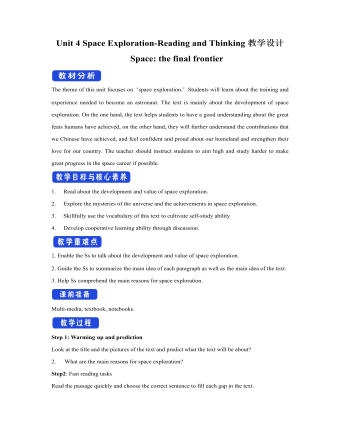
新人教版高中英语必修3Unit 4 Space Exploration-Reading and Thinking教学设计二
The theme of this unit focuses on “space exploration.” Students will learn about the training and experience needed to become an astronaut. The text is mainly about the development of space exploration. On the one hand, the text helps students to have a good understanding about the great feats humans have achieved, on the other hand, they will further understand the contributions that we Chinese have achieved, and feel confident and proud about our homeland and strengthen their love for our country. The teacher should instruct students to aim high and study harder to make great progress in the space career if possible.1. Read about the development and value of space exploration.2. Explore the mysteries of the universe and the achievements in space exploration.3. Skillfully use the vocabulary of this text to cultivate self-study ability 4. Develop cooperative learning ability through discussion.1. Enable the Ss to talk about the development and value of space exploration.2. Guide the Ss to summarize the main idea of each paragraph as well as the main idea of the text.3. Help Ss comprehend the main reasons for space exploration. Multi-media, textbook, notebooks.Step 1: Warming up and predictionLook at the title and the pictures of the text and predict what the text will be about?2. What are the main reasons for space exploration?
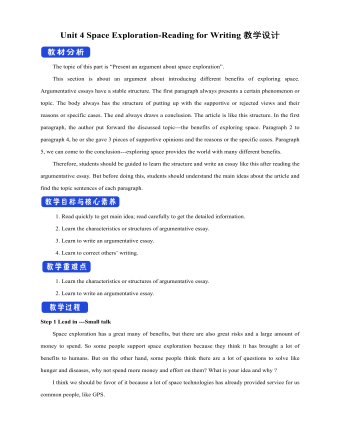
新人教版高中英语必修3Unit 4 Space Exploration-Reading for Writing教学设计二
⑦在我看来, 探索太空是值得的。As far as I am concerned, it is worthwhile to explore the space.Step 10 Writing---draftRecently, students in our class have had heated a discussion on whether space is worth exploring. Students hold different ideas about it.30% of us think space exploration is not worthwhile. They think space is too far away from us and our daily life and is a waste of money. And the money spent on space exploration can be used to solve the earth’s problems such as starvation and pollution.On the other hand,70% think space is worth exploring because we have benefited a lot from it,such as using satellites for communication and weather forecast. What’s more,with further space research,we may solve the population problem by moving to other planets one day. Also,space research will enable us to find new sources to solve the problem of energy shortages on the earth.As far as I am concerned, it is worthwhile to explore the space. Not only can it promote the development of society but also enrich our life. Step 11 Pair workExchange drafts with a partner. Use this checklist to help your partner revise his/her draft.1.Does the writer explain why he/she changed/wanted to change?2.Does the writer tell how the changes have improved or will improve his/her life?3.Is the text well-organised?4.Does the writer use words and expressions to show similarities and differences?5.Are there any grammar or spelling errors?6.Does the writer use correct punctuation?
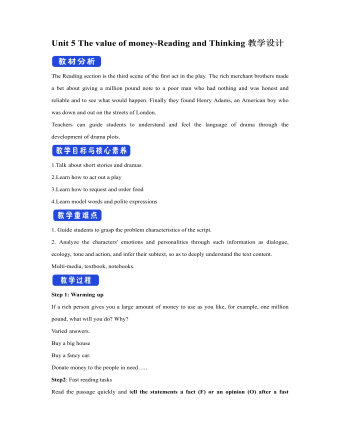
新人教版高中英语必修3Unit 5 The value of money-Reading and Thinking教学设计二
? Could you offer me some kind of work here?? I don’t want your charity, I just want an honest job.? Careless: I landed in Britain by accident.Step 7:Consolidation.? Find Henry? Roderick and Oliver were I .making a bet when they saw Henry, a poor young man. ? Know Henry? About a month ago, Henry was sailing and later he found himself carried out to sea by a strong wind. Fortunately, he 2.was spotted by a ship. And it was the ship that brought him to 3.England? Offer money to Henry ? Oliver and Roderick gave Henry a letter and told him that there was money in it. They 4.persuaded him to accept it, and made him 5.promise that it wouldn't be opened until 2 o'clock.Step 8:Language pointsa large amount of: a large quantity of; a great deal ofe.g. They bought a large amount of furniture before they moved their new house.make a bet: make an arrangement to risk money, etc. on an event of which the result is doubtful.e.g. We made a bet on the result of the match.permit sb to do something: allow somebody to do somethinge.g. My mother doesn’t permit me to ride in the street after it rained.by accident: as a result of chancee.g. I only found it by accident.stare at: look at somebody or something with the eyes wide open in a fixed gaze( in astonishment, wonder, fear, etc)to be honest: to tell you the truth; to be franke.g. To be honest, I don’t think we have a chance of winning.Step7 Homework:What do you think will happen to Henry? Will the bank-note help him or get him into trouble?

新人教版高中英语必修3Unit 5 The Value of Money-Reading for Writing教学设计二
2. 您能看到, 我头发太长了。You can see that my hair is much too long.3. 无论什么时候, 只要您想回来就回来。Please come back whenever you want.4. 您仅有很少的头发要理! You only have too little hair to cut !5. 为您服务是我的荣幸!It is my honour to serve you!Step 9 Writing(Henry is walking down the street when he sees a sign for a place that cuts hair. He decides to have it cut. )H=Henry B=BarberH: Good afternoon, I’d like to have my hair cut, if I may. (The barber looks at Henry’s hair and continues cutting another man’s hair. ) Er, I’d really like a haircut. As you can see it’s much too long. B: (in a rude manner) Yes, I can see that. Indeed, I can. H: Fine, well, I’ll have a seat then. (He sits in one of the barber’s chairs. The barber turns to look at Henry. )B: It’s quite expensive here, you know! Are you sure you can afford it?H: Yes. I think so. (After his hair is cut, the barber tells Henry how much he must pay. Henry shows the barber the bank note. )B: Why Mr. . . (looks shocked)H: Adams. Henry Adams. I’m sorry. I don’t have any change. B: Please don’t worry! (wearing a big smile) Nothing to worry about! Nothing at all! Please come back whenever you want, even if you only have too little hair to cut! It will be my honour to serve you!Step 10 Pair workExchange drafts with a partner. Use this checklist to help your partner revise his/her draft.1. Are all the elements of a play included and in good order ?2. Do the character use suitable language ?3. Are the stage directions clear and useful ?4. Is the plot clear and exciting enough ?
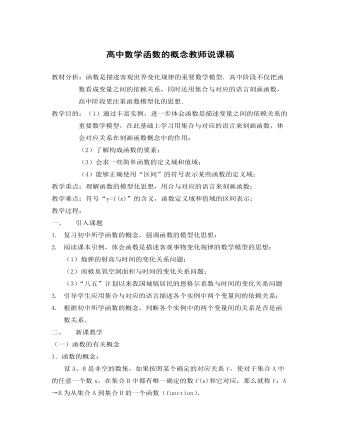
高中数学函数的概念教师说课稿
一、 引入课题1. 复习初中所学函数的概念,强调函数的模型化思想;2. 阅读课本引例,体会函数是描述客观事物变化规律的数学模型的思想:(1)炮弹的射高与时间的变化关系问题;(2)南极臭氧空洞面积与时间的变化关系问题;(3)“八五”计划以来我国城镇居民的恩格尔系数与时间的变化关系问题3. 引导学生应用集合与对应的语言描述各个实例中两个变量间的依赖关系;4. 根据初中所学函数的概念,判断各个实例中的两个变量间的关系是否是函数关系.
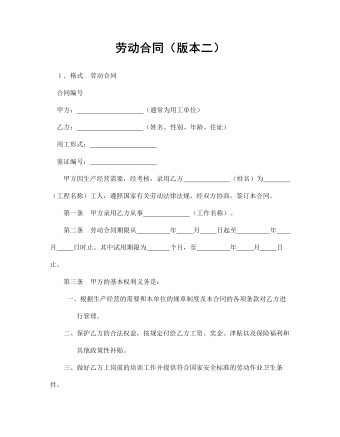
劳动合同(版本二)
甲方因生产经营需要,经考核,录用乙方 (姓名)为 (工程名称)工人,遵照国家有关劳动法律法规,经双方协商,签订本合同。 第一条 甲方录用乙方从事 (工作名称)。 第二条 劳动合同期限从 年 月 日起至 年 月 日时止。其中试用期限为 个月,至 年 月 日止。
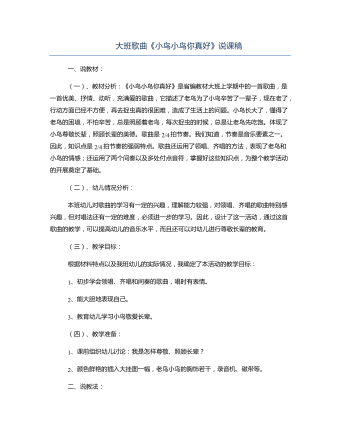
大班歌曲《小鸟小鸟你真好》说课稿
教材分析:《小鸟小鸟你真好》是省编教材大班上学期中的一首歌曲,是一首优美、抒情、动听,充满爱的歌曲,它描述了老鸟为了小鸟辛苦了一辈子,现在老了,行动方面已经不方便,再去捉虫真的很困难,造成了生活上的问题。小鸟长大了,懂得了老鸟的困境,不怕辛苦,总是照顾着老鸟,每次捉虫的时候,总是让老鸟先吃饱。体现了小鸟尊敬长辈,照顾长辈的美德。歌曲是2/4拍节奏。我们知道,节奏是音乐要素之一。因此,知识点是2/4拍节奏的强弱特点。歌曲还运用了领唱、齐唱的方法,表现了老鸟和小鸟的情感;还运用了两个间奏以及多处付点音符,掌握好这些知识点,为整个教学活动的开展奠定了基础。
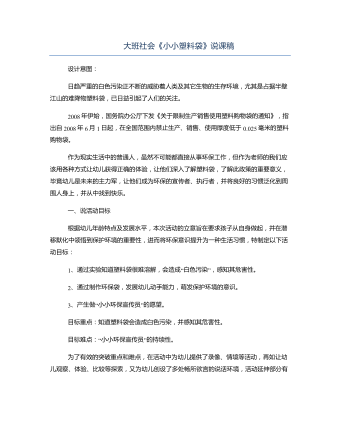
大班社会《小小塑料袋》说课稿
日趋严重的白色污染正不断的威胁着人类及其它生物的生存环境,尤其是占据半壁江山的难降物塑料袋,已日益引起了人们的关注。2008年伊始,国务院办公厅下发《关于限制生产销售使用塑料购物袋的通知》,指出自2008年6月1日起,在全国范围内禁止生产、销售、使用厚度低于0.025毫米的塑料购物袋。作为现实生活中的普通人,虽然不可能都直接从事环保工作,但作为老师的我们应该用各种方式让幼儿获得正确的体验,让他们深入了解塑料袋,了解此政策的重要意义,毕竟幼儿是未来的主力军,让他们成为环保的宣传者、执行者,并将良好的习惯泛化到周围人身上,并从中找到快乐。
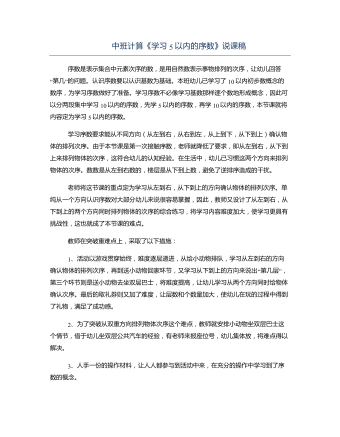
中班计算《学习5以内的序数》说课稿
序数是表示集合中元素次序的数,是用自然数表示事物排列的次序,让幼儿回答“第几”的问题。认识序数要以认识基数为基础。本班幼儿已学习了10以内初步数概念的数序,为学习序数做好了准备。学习序数不必像学习基数那样逐个数地形成概念,因此可以分两段集中学习10以内的序数,先学5以内的序数,再学10以内的序数,本节课就将内容定为学习5以内的序数。学习序数要求能从不同方向(从左到右,从右到左,从上到下,从下到上)确认物体的排列次序。由于本节课是第一次接触序数,老师就降低了要求,即从左到右,从下到上来排列物体的次序,这符合幼儿的认知经验。在生活中,幼儿已习惯这两个方向来排列物体的次序。数数是从左到右数的,楼层是从下到上数,避免了逆排序造成的干扰。
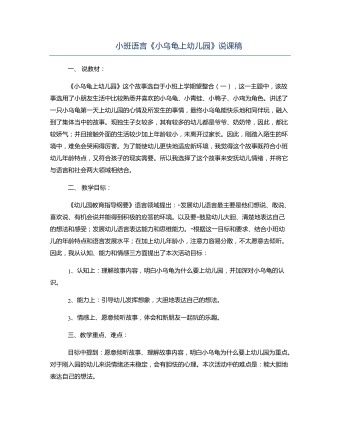
小班语言《小乌龟上幼儿园》说课稿
《小乌龟上幼儿园》这个故事选自于小班上学期望整合(一),这一主题中,该故事选用了小朋友生活中比较熟悉并喜欢的小乌龟、小青蛙、小鸭子、小鸡为角色。讲述了一只小乌龟第一天上幼儿园的心情及所发生的事情,最终小乌龟能快乐地和同伴玩,融入到了集体当中的故事。现独生子女较多,其有较多的幼儿都是爷爷、奶奶带,因此,都比较娇气;并且接触外面的生活较少加上年龄较小,未离开过家长。因此,刚踏入陌生的环境中,难免会哭闹得厉害。为了能使幼儿更快地适应新环境,我觉得这个故事既符合小班幼儿年龄特点,又符合孩子的现实需要。所以我选择了这个故事来安抚幼儿情绪,并将它与语言和社会两大领域相结合。

人教版小学语文下册说课稿《学弈》《两小儿辩日》
一、说教材 1.教材内容:九年义务教育六年制小学语文第十一册第八组第二十五课《学弈》。 2.教材简析:《学弈》这篇文言文选自《孟子·告子》,通过弈秋教两个人学下围棋的事,说明了做事必须专心致志,决不可三心二意的道理。文章先说弈秋是全国最擅长下围棋的人,然后讲弈秋同时教两个学习态度不同的人下围棋,学习效果截然不同,最后指出这两个人学习结果不同,并不是在智力上有多大差异。文言文是古代文明传承的媒介,虽与现代文在用词造句、朗读上有很大差别,但两者却有着千丝万缕、不可分割的内在联系
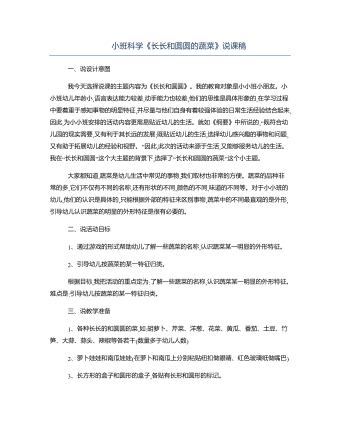
小班科学《长长和圆圆的蔬菜》说课稿
我今天选择说课的主题内容为《长长和圆圆》。我的教育对象是小小班小朋友。小小班幼儿年龄小,语言表达能力较差,动手能力也较差,他们的思维是具体形象的,在学习过程中要着重于感知事物的明显特征,并尽量与他们自身有着较强体验的日常生活经验结合起来,因此,为小小班安排的活动内容更需易贴近幼儿的生活。就如《纲要》中所说的,“既符合幼儿园的现实需要,又有利于其长远的发展;既贴近幼儿的生活,选择幼儿感兴趣的事物和问题,又有助于拓展幼儿的经验和视野。”因此,此次的活动来源于生活,又能够服务幼儿的生活。我在“长长和圆圆”这个大主题的背景下,选择了“长长和圆圆的蔬菜”这个小主题。大家都知道,蔬菜是幼儿生活中常见的事物,我们取材也非常的方便。蔬菜的品种非常的多,它们不仅有不同的名称,还有形状的不同,颜色的不同,味道的不同等。对于小小班的幼儿,他们的认识是具体的,只能根据外部的特征来区别事物,蔬菜中的不同最直观的是外形,引导幼儿认识蔬菜的明显的外形特征是很有必要的。
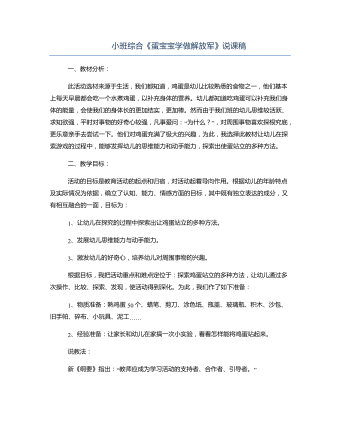
小班综合《蛋宝宝学做解放军》说课稿
此活动选材来源于生活,我们都知道,鸡蛋是幼儿比较熟悉的食物之一,他们基本上每天早晨都会吃一个水煮鸡蛋,以补充身体的营养。幼儿都知道吃鸡蛋可以补充我们身体的能量,会使我们的身体长的更加结实,更加棒。然而由于我们班的幼儿思维较活跃、求知欲强,平时对事物的好奇心较强,凡事爱问:“为什么?”,对周围事物喜欢探根究底,更乐意亲手去尝试一下。他们对鸡蛋充满了极大的兴趣,为此,我选择此教材让幼儿在探索游戏的过程中,能够发挥幼儿的思维能力和动手能力,探索出使蛋站立的多种方法。活动的目标是教育活动的起点和归宿,对活动起着导向作用。根据幼儿的年龄特点及实际情况为依据,确立了认知、能力、情感方面的目标,其中既有独立表达的成分,又有相互融合的一面,目标为:1、让幼儿在探究的过程中探索出让鸡蛋站立的多种方法。2、发展幼儿思维能力与动手能力。3、激发幼儿的好奇心,培养幼儿对周围事物的兴趣。

幼儿园小学说课稿教案植树造林
二、活动目标: 基于这样一种教育思想,接下来我来说说为本次活动制订的目标。幼儿教育的任何一个目标都应该为幼儿的终生发展作准备,社会教育也不例外。根据幼儿的发展水平、经验、和需要我设计了以下几个目标,分别对幼儿知识、情感、能力方面进行积极的引导。1、知道树木是人类、动物的好朋友,了解绿化的好处,初步产生环保意识。2、迁移生活经验,激发幼儿热爱和亲近大自然的情感。3、通过看看、说说、听听发展幼儿语言表达能力、判断能力。我把活动目标一做为本次活动的重点和难点。

小班计算《感知4以内的数》说课稿
二、说准备:为了更好的进行教学,我为本次教学活动准备了,挂图,铃铛,幼儿操作材料等。三、说教法学法:这一节课的教学对象是小班幼儿。他们年龄小、好动、爱玩、好奇心强,注意力容易分散。根据这一特点,为了抓住他们的兴趣,激发他们的好奇心,我采用了愉快式教学方法为主,创设情境,设计了以游戏的形式,让幼儿在游戏中学习,充分发挥幼儿的学习积极性。为了更好地突出幼儿的主体地位,在整个教学过程中,通过让幼儿听一听,数一数、说一说、做一做等多种形式,让幼儿积极动眼、动耳、动脑、动口,引导幼儿通过自己的学习体验来学习新知,积极开展本节课的教学活动。四、说程序设计:课堂教学是幼儿数学知识的获得、技能技巧的形成、智力、能力的发展以及思想品德的养成的主要途径。为了达到预期的教学目标,我对整个教学过程进行了系统地规划,遵循目标性、整体性、启发性、主体性等一系列原则进行教学设计。设计了四个主要的教学程序:

